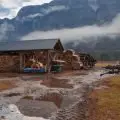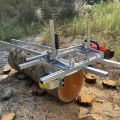Whether you already own a chainsaw or you’re about to purchase one, it’s important to know about all the main parts of a chainsaw. Of course, the chain, engine, and handles need little introduction, but it’s helpful to learn about the other parts. This chainsaw parts list guide will provide you with all the relevant information you need on the parts of a chainsaw.
Table of Contents

The Parts of a Chainsaw
- Throttle
- Throttle Interlock
- Anti-Vibration System
- Chain Catcher
- Chain Brake
- Handguard
- Muffler
- Guide Bar
- Chain
- Engine
- Chain Tensioner
- Clutch/Sprocket
- Flywheel
- Pull Cord
- Decompression Valve
- Spark Arrestor
- Carburetor
- Air Filter
- Spark Plug
- Choke Valve
- Bucking Spikes
- Fuel Tank
- Lubricant Tank
- High/Low Adjustment
- Summer/Winter Shutter
As you know, all chainsaws are not the same.
For starters, we have gas and electric-powered chainsaws, serving the same purpose and operating in a similar fashion but having different parts. Each chainsaw brand has its own design, and because of this, not all chainsaws will have the same parts in the exact same position. Therefore, it’s important to understand that not every part listed in this article is on every single chainsaw.
When it comes to the various parts of a chainsaw, we can divide them up into OSHA-required parts and additional parts. The OSHA (Occupational Safety and Health Administration) parts are a requirement for chainsaws to meet a set of safety standards. The additional parts are not requirements but are common parts to understand on a chainsaw.
In addition to the OSHA requirements, any chainsaw placed into service after February 9, 1995, must meet the requirements of ANSI B175.1-1991 (Gasoline-Powered Chainsaws Safety Requirements).
OSHA Parts of a Chainsaw
1. Throttle
The throttle is the component that controls the speed of the chainsaw chain. The throttle controls how much fuel gets to the combustion cylinders in a gas chainsaw. The throttle in an electric or battery-powered chainsaw regulates the motor’s amperage.
Learn more about electric vs gas chainsaws in our guide!
Key takeaways:
- More fuel = more speed (gas)
- More amperage = more power (electric)
2. Throttle Interlock
The throttle interlock is a key safety feature to prevent the throttle from being activated by accident. The throttle interlock must be pressed before you are able to unlock and activate the throttle on the chainsaw.
3. Anti-Vibration System
The anti-vibration system is designed to absorb and reduce the stress that’s put on the user’s hands, arms, and joints while operating the chainsaw. This component is particularly important when you are using a chainsaw for an extended period of use.
4. Chain Catcher
The chain catcher is another very important safety component on a chainsaw. The chain catcher, a unique device, is made to catch the chainsaw chain in the event that it snaps and breaks while spinning. This safety feature is essential for protecting the user from getting injured by a snapped chain.
5. Chain Brake
The chain brake is designed to stop the chain from spinning when a sudden kickback occurs. Chainsaw kickback can happen when the chain tip gets nicked, or the chain gets pinched during operation. Kickback is a dangerous and fast upward thrust of the blade back toward the user. Therefore, the chain brake prevents serious cutting injuries from occurring.
A chain brake can be either:
- Manual – a handguard that gets pressed during the kickback.
- Inertia-activated – an automatic response based on force.
Learn more about what is chainsaw kickback and how to prevent it in our guide!
6. Handguard
The handguard is essentially a shield that protects the operator’s hands from any flying debris during use, as well as aiding in protection against the top of the spinning chain.
7. Muffler
The muffler is an essential part of gas chainsaws that helps to reduce the noise level. A gas-powered chainsaw would be far too loud to operate or stand near without causing damage to your hearing if it didn’t have a muffler.
Additional Parts of a Chainsaw
8. Guide Bar
The guide bar is a metal bar that holds the chain in place, keeping it straight while the chain spins around for cutting.
- Oregon bar and chain combo: Replacement 18-inch (45cm) guide bar and 62 drive link chainsaw chain, premium quality combination, 3/8-inch low profile pitch and .050-inch (1.3 mm) gauge
- Fits several chainsaw models, including from: Echo, Craftsman, McCulloch, Homelite, Poulan,Makita, Ryobi and more; see description. For saw sizes up to 42cc. ID link on chain for easy replacement
- Featuring Oregon’s special LubriTec oiling system: Keeps your chain and guide bar automatically oiled, for less friction and longer life
- Ideal for occasional commercial users: For professionals and homeowners. Chain is durable and easy to maintain, with a forgiving performance
- Low kickback spare saw chain: High performance, lightweight, heavy duty and reversible guide bar, with low kickback design for improved safety. Meets recoil performance requirements of ANSI B175.1-2
Prices pulled from the Amazon Product Advertising API on:
Product prices and availability are accurate as of the date/time indicated and are subject to change. Any price and availability information displayed on [relevant Amazon Site(s), as applicable] at the time of purchase will apply to the purchase of this product.
9. Chain
The real cutting action of a chainsaw is performed by the chain. The chain has pointed teeth that are spaced apart (pitch) and have a particular width (gauge). Not all chainsaw chains are universal, and each chainsaw has a specific size chain that is required.
Visit our chainsaw chain sizes guide for all the different types of chainsaw chains and their sizes.
- Durable, low-kickback, low-vibration chain helps reduce user fatigue for increased periods of work. For all chainsaws brands that run 3/8 Inch pitch, .050 Inch (1.3 mm) gauge, 56 drive link chain
- Fits these chainsaw models with a 16 bar: Craftsman: S160, S165, CMECS600, CMXGSAMN4216; Earthwise CS30116, CS33016; Homelite ZR43100, UT43123; Husqvarna 240, 135, 120 Mark II
- Also fits: Makita UC4051A, XCU03, XCU04CM; Oregon CS1400; Poulan PR4218, PL1416, PL3816; Remington RM1645; Ryobi RY3716; Sun Joe SWJ701E; Wen 40417, Troy-Bilt TB4216 and more
- Tough, long-lasting chrome outer layer and hardened rivets help reduce wear and allow for fewer chain adjustments
- Built-in Lubri-Tec automatic oiling system extends the life of your chain by delivering oil to key parts of the chain, so you can work smarter with less downtime and maintena
Prices pulled from the Amazon Product Advertising API on:
Product prices and availability are accurate as of the date/time indicated and are subject to change. Any price and availability information displayed on [relevant Amazon Site(s), as applicable] at the time of purchase will apply to the purchase of this product.
10. Engine
No list of chainsaw parts would be complete without mentioning the engine. The engine will be either gas-powered, electric (corded), or battery-powered.
11. Chain Tensioner
The chain tensioner is designed to control the tension of the chain on the guide bar. The chain tensioner helps you keep proper tension on the chain, so the chainsaw is able to produce smooth and safe cuts.
Key takeaways:
- The chain won’t spin quickly if it is excessively tight.
- The chain could come off while spinning if it is too loose.
12. Clutch/Sproket
The chain sprocket is where the clutch is fastened. The clutch regulates how the chain revolves around the guide bar.
13. Flywheel
The flywheel regulates the engine’s speed and aids in cooling the motor to prevent overheating.
14. Pull Cord
The pull cord is used to turn the engine to get it started initially. It’s typically made from a small rope with a plastic handle that you pull on.
15. Decompression Valve
The decompression valve in gas chainsaws releases compression from the combustion chamber during the starting procedure. When pulling the starter rope, the decompression valve greatly simplifies the process of starting the chainsaw.
16. Spark Arrestor
The spark arrestor is a mesh-like screen that sits inside the muffler. The spark arrestor is designed to prevent any small particulates, such as metal pieces, from flying out of the chainsaw. This ultimately prevents injury, and, depending on the situation, could also prevent fire hazards.
17. Carburetor
The carburetor’s role is to control the fuel intake of the engine.
18. Air Filter
The air filter’s purpose is to prevent particles like sawdust, dirt, and other impurities from clogging the engine. An air and fuel mixture is needed to run a gas chainsaw. The filter makes sure that only pure air enters the engine.
19. Spark Plug
The actual spark plug on a chainsaw is like a smaller version of the spark plug you would put in a car. The purpose of a spark plug is to ignite the fuel in the engine. Just like with the air filter, a spark plug can get worn out over time and may need to be replaced occasionally, depending on a few factors like how frequently and how hard you use your chainsaw.
20. Choke Valve
The choke valve aids in the chainsaw’s initialization phase. The carburetor’s air and fuel intake is managed by the choke valve to ensure that it is at the proper level.
21. Bucking Spikes
With the aid of bucking spikes, you may drive the chainsaw deeper into a log and make straighter cuts. When cutting in this way, the bucking spikes also aid in preventing chainsaw kickback. Other names for bucking spikes include “dogs” and “bumper spikes.”
22. Fuel Tank
The fuel tank is where you put the gas/oil fuel mixture in your chainsaw. It’s important to have the right ratio, with most chainsaws using a mix ratio of 50:1 or 40:1.
23. Lubricant Tank
The chainsaw bar and chain oil are inserted into the chainsaw through the lubricating tank. Through the application of a lubricant, the metal-on-metal contact between the chainsaw’s bar and chain decreases friction and heat.
24. High/Low Adjustment
Most chainsaws will have a few different adjustment screws, marked with “H” and “L”, the High/Low adjustment screws. These screws control the idling speed of your chainsaw, allowing you to tweak the minimum and maximum RPM. If you need to make an adjustment, you should refer to your chainsaw’s user manual for specific instructions for your chainsaw.
25. Summer/Winter Shutter
The purpose of the summer/winter shutter is to provide control of the airflow in and out of the engine. For instance:
- In summer (warmer climates) – you want the engine to pull air from outside the machine because it will be cooler than inside.
- In winter (colder climates) – you want the engine to pull the pre-warmed air inside the machine, rather than the cold air outside.
The summer/winter shutter allows you to control these air flows, by opening or blocking a small passageway inside your chainsaw. This part can look very different from a chainsaw to chainsaw, however, the working principle is always the same.
Chainsaw Parts FAQs
What are the parts of a chainsaw called?
The most notable parts of a chainsaw are the engine, throttle, throttle lock, guide bar, chain, chain brake, chain guard, muffler, anti-vibration system, and handguard.
What are the spikes on a saw called?
Bucking spikes, also known as bumper spikes, and dogs, are the spikes that help you dig the chainsaw into a log so you are able to perform straighter cuts. These spikes also help to prevent chainsaw kickback from occurring when cutting.
What is the part that turns the chain on a chainsaw?
The clutch (attached to the chain sprocket) is the component that controls the spinning of the chain around the guide bar on a chainsaw.







